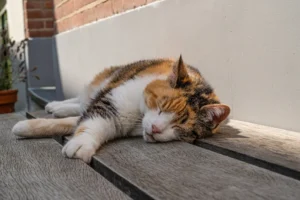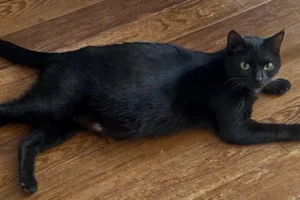Cats are known for their independent and mysterious nature, but have you ever wondered why they never seem to break a sweat, even in the sweltering summer heat? The reason behind this peculiar feline trait is quite fascinating and goes beyond just keeping cool. Let’s take a closer look at why cats do not sweat and how they have evolved to regulate their body temperature in unique ways.
The Lack of Sweat Glands in Cats
Cats are known for their grooming habits, but did you know that they also have a unique way of cooling down without sweating? Unlike humans and other animals, cats do not have sweat glands all over their bodies. This lack of sweat glands means that cats cannot rely on sweating to regulate their body temperature like we do.
Instead, cats have sweat glands only in their paw pads. These sweat glands help them leave behind scent markers and, to a small extent, help with cooling. However, since these glands are not widespread like in humans, sweating is not an efficient method for cats to cool down. This is why you might not see your cat panting or sweating heavily when they are hot.
Without the ability to sweat like humans do, cats rely on other cooling strategies to regulate their body temperature effectively. One common method they use is grooming behavior.
Grooming Behavior and Cooling Strategies
Cats are meticulous groomers, and this behavior serves a dual purpose: keeping their fur clean and helping them regulate their body temperature. When a cat licks its fur, the saliva evaporates and cools the cat down. This process is similar to how sweating helps humans cool off.
Additionally, cats may seek out cooler areas in the house, such as lying on a tile floor or near a window with a breeze. They may also groom themselves more frequently during hot weather to help dissipate heat.
Another interesting cooling strategy cats employ is hunting at night. Since cats are crepuscular animals, meaning they are most active during dawn and dusk, they may choose to hunt during these cooler hours to avoid overheating.
By understanding the lack of sweat glands in cats and their grooming behaviors, we can appreciate how these fascinating animals have adapted to regulate their body temperature effectively. Whether they’re lounging in a cool spot or meticulously cleaning themselves, cats have unique ways of staying cool without sweating.
Panting as a Cooling Mechanism
Have you ever noticed your cat panting when it’s hot? Unlike humans, cats do not sweat like we do. Instead, they rely on a different cooling mechanism – panting. When a cat pants, it helps to release excess heat from their bodies through the evaporation of moisture from their respiratory tract. This behavior is crucial for cats to regulate their body temperature and prevent overheating. So, if you see your furry friend panting on a hot day, don’t be alarmed – it’s just their natural way of staying cool.
Heat Tolerance and Adaptations
Cats are impressive creatures when it comes to handling heat. Their bodies have evolved with remarkable heat tolerance and adaptations that allow them to thrive in various climates without the need to sweat. One such adaptation is their dense fur coat, which not only protects them from the sun but also acts as insulation to regulate their body temperature. Additionally, cats have highly efficient sweat glands located on their paw pads, which help them sweat minimally when needed. These combined adaptations enable cats to maintain their cool even in the hottest of conditions.
Additional Unique Insight:
– Cats also have a higher tolerance for heat compared to humans due to their ability to conserve energy by sleeping for most of the day. This contributes to their overall resilience in coping with hot weather.
Remember, understanding why cats do not sweat sheds light on their incredible natural cooling mechanisms and evolutionary adaptations. So next time you see your cat lounging comfortably in the summer heat, you can appreciate their remarkable ability to stay cool without breaking a sweat.
Importance of Hydration for Cats
Cats are notorious for their aversion to water, but did you know that their lack of sweat glands plays a significant role in this behavior? Without the ability to sweat like humans, cats rely on other means to regulate their body temperature. This makes staying hydrated crucial for our feline friends, especially during hot weather or vigorous play. Keeping fresh water available at all times and incorporating wet food into their diet can help prevent dehydration and keep them cool.
Signs of Overheating in Cats
Spotting the signs of overheating in your cat is essential for their well-being. Unlike us, cats cannot regulate their body temperature by sweating, so they are more susceptible to heat-related issues. Watch out for symptoms like panting excessively, lethargy, drooling, and red gums. If you notice any of these signs, move your cat to a cooler area, provide fresh water, and gently dampen their fur with a wet cloth to help them cool down. Remember, quick action can make all the difference in preventing heatstroke in your furry companion.
Unique Insight:
Did you know that cats can release some heat through their paw pads? Encouraging your cat to rest on cool surfaces like tiles or offering a cool pack wrapped in a towel can help them naturally lower their body temperature. This small tip can make a big difference in keeping your cat comfortable during hot days.
Fun Facts About Cats and Heat Regulation
Have you ever wondered why cats never seem to break a sweat, even on the hottest days? It all boils down to their unique way of keeping cool. Cats do not have sweat glands like humans do, which means they can’t rely on sweating to regulate their body temperature. Instead, they have developed other ingenious methods to beat the heat.
One cool fact about cats is that they rely on panting to release excess heat from their bodies. You may have noticed your feline friend sticking out their tongue and breathing rapidly – this is their way of cooling down. Additionally, cats have specialized sweat glands located in their paws. When they sweat through these glands, it helps them leave scent markings behind as well as a way to cool off.
While cats may not sweat like humans, they have a highly efficient cooling system that helps them thrive in various climates. By grooming themselves regularly, cats spread saliva on their fur, which evaporates and provides a cooling effect. This self-grooming behavior is not just about looking good – it’s also a crucial aspect of heat regulation for our purring companions.
Next time you see your cat lounging in the sun or taking a catnap in a cozy spot, remember that their cool facade is all thanks to their smart adaptations for handling heat.
Additional Insight:
Did you know that a cat’s whiskers play a role in helping them sense changes in temperature and air circulation? Whiskers are highly sensitive and can detect even subtle shifts in the environment, allowing cats to adjust their behavior accordingly to stay comfortable. This unique feature adds another layer to the fascinating ways cats have evolved to survive and thrive in various conditions.
Remember, while cats may not sweat like humans, they have a range of other tricks up their sleeves to stay cool and comfortable in any situation.
Alex, a passionate animal lover, has experience in training and understanding animal behavior. As a proud pet parent to two dogs and three cats, he founded AnimalReport.net to share insights from animal experts and expand his knowledge of the animal kingdom.









